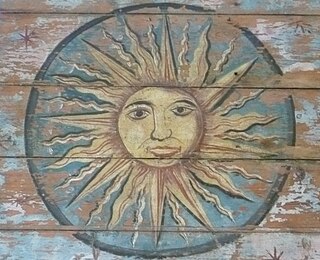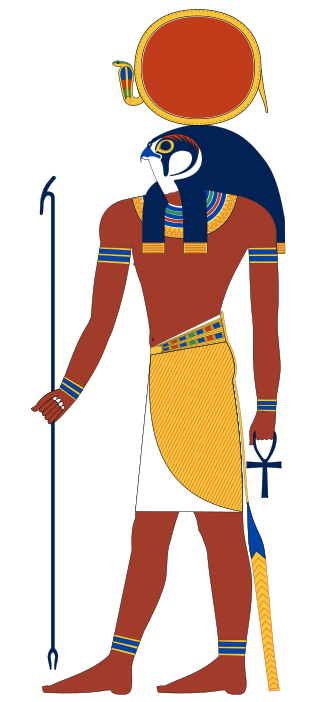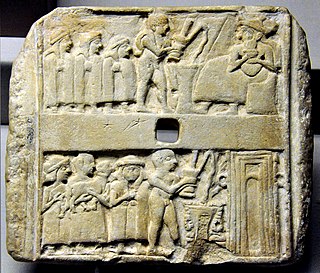Related Research Articles

A solar deity or sun deity is a deity who represents the Sun or an aspect thereof. Such deities are usually associated with power and strength. Solar deities and Sun worship can be found throughout most of recorded history in various forms. The Sun is sometimes referred to by its Latin name Sol or by its Greek name Helios. The English word sun derives from Proto-Germanic *sunnǭ.
A creator deity or creator god is a deity responsible for the creation of the Earth, world, and universe in human religion and mythology. In monotheism, the single God is often also the creator. A number of monolatristic traditions separate a secondary creator from a primary transcendent being, identified as a primary creator.
In Hawaiian mythology, Nu'u was a man who built an ark with which he escaped a Great Flood. He landed his vessel on top of Mauna Kea on the Big Island. Nu'u mistakenly attributed his safety to the moon, and made sacrifices to it. Kāne, the creator god, descended to earth on a rainbow and explained Nu'u's mistake. The myth has been interpreted as depicting the hazards of the Oceanian environment and local peoples' ability to withstand them. Missionaries to Hawaii in the 19th century considered him analogous to Noah of the Bible.

Proto-Indo-European mythology is the body of myths and deities associated with the Proto-Indo-Europeans, speakers of the hypothesized Proto-Indo-European language. Although the mythological motifs are not directly attested – since Proto-Indo-European speakers lived in preliterate societies – scholars of comparative mythology have reconstructed details from inherited similarities found among Indo-European languages, based on the assumption that parts of the Proto-Indo-Europeans' original belief systems survived in the daughter traditions.

Hittite mythology and Hittite religion were the religious beliefs and practices of the Hittites, who created an empire centered in what is now Turkey from c. 1600–1180 BC.

The Sun, as the source of energy and light for life on Earth, has been a central object in culture and religion since prehistory. Ritual solar worship has given rise to solar deities in theistic traditions throughout the world, and solar symbolism is ubiquitous. Apart from its immediate connection to light and warmth, the Sun is also important in timekeeping as the main indicator of the day and the year.
Malagasy mythology is rooted in oral history and has been transmitted by storytelling, notably the Andriambahoaka epic, including the Ibonia cycle. At least 6% of Madagascar are adherents of the religion, which is known as Fomba Gasy, and surveys show it is likely at least half practice some aspects of it. Adherence to Fomba Gasy is high amongst the Sakalava people, as they are reluctant to convert to faiths of foreign origin.
Deng, also known as Denka, is a sky, rain, and fertility god in Dinka mythology for the Dinka people of Sudan and South Sudan. He is the son of the goddess Abuk.

Ra or Re was the ancient Egyptian deity of the Sun. By the Fifth Dynasty, in the 25th and 24th centuries BC, he had become one of the most important gods in ancient Egyptian religion, identified primarily with the noon-day sun. Ra ruled in all parts of the created world: the sky, the Earth, and the underworld. He was believed to have ruled as the first pharaoh of Ancient Egypt. He was the god of the sun, order, kings and the sky.

Sumerian religion was the religion practiced by the people of Sumer, the first literate civilization found in recorded history and based in ancient Mesopotamia, and what is modern day Iraq. The Sumerians widely regarded their divinities as responsible for all matters pertaining to the natural and social orders of their society.

A liminal deity is a god or goddess in mythology who presides over thresholds, gates, or doorways; "a crosser of boundaries". These gods are believed to oversee a state of transition of some kind; such as, the old to the new, the unconscious to the conscious state, the familiar to the unknown.

Inca mythology is the universe of legends and collective memory of the Inca civilization, which took place in the current territories of Colombia, Ecuador, Peru, Bolivia, Chile, and Argentina, incorporating in the first instance, systematically, the territories of the central highlands of Peru to the north.

Bantu religion is the system of beliefs and legends of the Bantu people of Africa. Although Bantu peoples account for several hundred different ethnic groups, there is a high degree of homogeneity in Bantu cultures and customs, just as in Bantu languages. Many Bantu cultures traditionally believed in a supreme god whose name is a variation of Nyambe/Nzambe.

The creation of life from clay can be seen as a miraculous birth theme that appears throughout world religions and mythologies. It can also be seen as one of gods who craft humans out of earthly materials. As such, this class of story falls within a larger set of divine or cosmogonic origin stories about creation, whether through divine emergence or divine craft.
Ratovantany, also known as Andriantompo, is a self-creating Malagasy deity associated with the earth. He is most prominently featured in the Malagasy creation myths, where he makes a deal with the sky god Zanahary to create humanity; having crafted human beings from soil, Ratovantany reclaims the corpse upon death and decomposes it, while the soul belongs to Zanahary and thus the sky or the sun. Unlike Zanahary, Ratovantany appears to not have been a prominent deity to any Malagasy peoples, though this creation myth is ubiquitous in Malagasy cultures.
Abassi is the supreme creator god of the Efik, Ibibio, and Annang people of Nigeria. The depiction of Abassi in Efik and Annang traditions is influenced by Ibibio mythology since the two groups used to be part of the Ibibio before they migrated to different parts of southeast Nigeria and formed their own societies.
References
- ↑ Arthur Cotterell, A Dictionary of World Mythology, Oxford University Press, 17/04/1986
- ↑ "Madagascar Creation Myth" (PDF).
- ↑ Arthur Cotterell, A Dictionary of World Mythology, Oxford University Press, 17/04/1986
- ↑ Littleton, C. Scott (2005). Gods, goddesses, and mythology. Marshall Cavendish. p. 74. ISBN 9780761475590.
- ↑ "ASK BALLADEER: IS THERE A MALAGASY SOLAR DEITY?". Balladeer's Blog. 2018-06-03. Retrieved 2018-06-14.
- ↑ Arthur Cotterell, A Dictionary of World Mythology, Oxford University Press, 17/04/1986